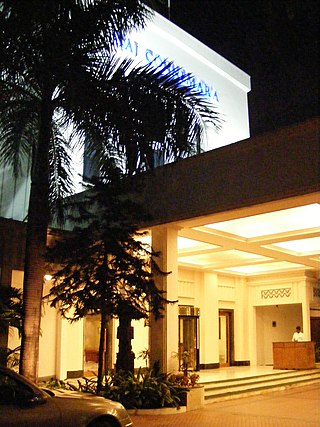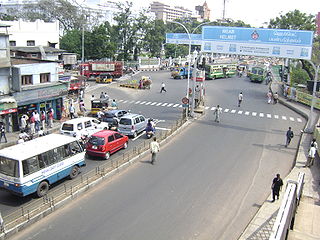List of heritage structures
| | This section needs expansion. You can help by adding to it. (April 2013) |
| S.No | Building | Architectural style | Year of construction | Architect | Neighborhood | Notes | Image |
|---|---|---|---|---|---|---|---|
| 1. | Parthasarathy Temple | Dravidian architecture | c. 6th century CE | Triplicane | Built by Narasimhavarman I. Considered the oldest structure in Chennai. [10] |  | |
| 2. | Vedapureeswarar Temple | Dravidian architecture | Before 7th century CE | Thiruverkadu | Built by the Cholas |  | |
| 3. | Descent of the Ganges | Dravidian architecture | c. 7th century CE | Mahabalipuram | One of the Group of Monuments at Mamallapuram that were designated as a UNESCO World Heritage Site since 1984. [11] |  | |
| 4. | Kapaleeshwarar Temple | Dravidian architecture | c. 7th century CE | Mylapore | Built by the Pallava kings. | 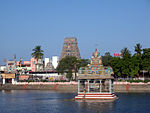 | |
| 5. | Thyagaraja Temple | Dravidian architecture | c. 7th century CE | Tiruvottiyur | Built by the Pallava kings. |  | |
| 6. | Marundeeswarar Temple | Dravidian architecture | c. 7th century CE | Thiruvanmiyur | Expanded during the Chola dynasty. [12] |  | |
| 7. | Bhaktavatsala Perumal Temple | Dravidian architecture | Before 820 CE | Thirunindravur | Built during the Pallava's reign. [13] |  | |
| 8. | Dhenupureeswarar Temple | Dravidian architecture | c. 957–970 CE | Madambakkam | Built during the reign of the Chola king, Parantaka Chola II, father of Raja Raja Chola I, who constructed the Brihadeeswarar Temple in Thanjavur. Consolidated with stones during the reign of Kulothunga Chola I. [14] [15] |  | |
| 9. | Masilamaniswarar Temple | Dravidian architecture | c. 9th or 10th century CE (before 970 CE) | Thirumullaivoyal | Built during the Chola era. [16] [17] |  | |
| 10. | Thiruporur Kandaswamy temple | Dravidian architecture | c. 10th century CE | Thiruporur | Built during the Pallava era. [18] |  | |
| 11. | Tirusoolanathar Temple | Dravidian architecture | 11th century CE | Tirusulam | Built by Kulothunga Chola I around 11th century CE. [19] |  | |
| 12. | Tiruvalithayam Tiruvallesvarar Temple | Dravidian architecture | c. 11th century CE | Padi | The temple dates back to several centuries earlier. The presiding deity of the temple is revered in the 7th-century Tamil Shaivite canonical work, the Tevaram . [20] Existing structure built during the reign of the Chola dynasty around 11th century CE. |  | |
| 13. | Velveeswarar Temple | Dravidian architecture | c. 11th century CE | Valasaravakkam | Constructed by Kulothunga Chola I (reigned c. 1070–1122 CE). | ||
| 14. | Mylapore Karaneeswarar Temple | Dravidian architecture | c. 12th century CE | Mylapore |  | ||
| 15. | Kundrathur Murugan Temple | Dravidian architecture | 12th century CE | Kundrathur | Built by Kulothunga Chola II (r. 1133–1150 CE). |  | |
| 16. | Kurungaleeswarar Temple | Dravidian architecture | 12th century CE | Koyambedu | Dates back to the Kulothunga Chola period (c. 1133–1150 CE). | ||
| 17. | Saidapet Prasanna Venkatesa Perumal Temple | Dravidian architecture | c. 12th century CE [21] | Saidapet | Constructed by the Balija Chetty community under the aegis of the Vijayanagara monarchs. [22] | ||
| 18. | Kundrathur Kandhalheeswarar Temple | Dravidian architecture | Before 1241 CE | Kundrathur | Details of temple renovations from time to time are found in epigraphic findings dating back 1241 CE during the Rajaraja Chola period. [23] |  | |
| 19. | Kundrathur Nageswarar Temple | Dravidian architecture | 12th century CE | Kundrathur | Built by Sekkilar during 12th century CE. [24] | ||
| 20. | Ekambareswarar–Valluvar Temple | Dravidian architecture | Before early 16th century CE | Mylapore | Also known as the Thiruvalluvar Temple. Built on an older structure that is said to be in existence since antiquity. [25] [26] |  | |
| 21. | Church of Our Lady of Light | Herrerian | 1516 [27] | Mylapore | Built by Portuguese explorers in Mylapore Chennai and has a oldest Madonna Painting of Mary with Jesus up in the Altar. |  | |
| 22. | Fort St. George | 1640 | George Town | First major British settlements in India, leading to the foundation of the city of Madras. One of the 163 notified areas (megalithic sites) in the state of Tamil Nadu. [28] |  | ||
| 23. | Kalikambal Temple | Dravidian architecture | c. 1640 | George Town | Originally located by the seashore and was relocated to the current site in 1640 CE. Visited incognito by the Maratha warrior Shivaji on 3 October 1667. [29] [30] : 384 |  | |
| 24. | St Mary's Co-Cathedral | 1658 [31] | George Town |  | |||
| 25. | Kandaswami Temple | Dravidian architecture | c. 1670s | George Town | Built by Maari Chettiar. The existing stone reinforcement was made during the early 1800s. [32] | ||
| 26. | St. Mary's Church | 1680 | Fort St. George |  | |||
| 27. | Dargha of Sufi Saint Syed Moosa Sha Khaderi | 17th century | Anna Salai |  | |||
| 28. | Kachchaleswarar Temple | Dravidian architecture | 1725 | George Town | Built by Kalavai Chetty, a 'dubash' working for the British East India Company, on a land belonging to him. [30] : 383 |  | |
| 29. | Chennakesava Perumal Temple | Dravidian architecture | 1762 | George Town | Originally dates back to 1646, along with Mallikesvarar Temple as twin temples. Rebuilt in a new location in 1762. [33] [34] |  | |
| 30. | Mallikesvarar Temple | Dravidian architecture | 1762 | George Town | Originally dates back to 1646, along with Chennakesava Perumal Temple as twin temples. Rebuilt in a new location in 1762. [33] [34] |  | |
| 31. | Chepauk Palace | Indo-Saracenic | Around 1764 | Chepauk | The official residence of the Nawab of Arcot from 1768 to 1855 |  | |
| 32. | Triplicane Big Mosque | Mughal | 1765 [27] | Triplicane |  | ||
| 33. | Madras Club (Moubray's Cupola) | 1780s | Adyar | Originally a spacious colonial bungalow, known as Moubray's Cupola, set in 105 acres of parkland and later became the Adyar Club. Built by George Moubray on the banks of the Adyar in the 1780s. [35] | |||
| 34. | Government Museum Buildings | Indo-Saracenic | 1789 | Henry Irwin | Egmore | Constructed between 1789 and 1890 | 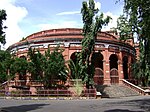 |
| 35. | Amir Mahal | Indo-Saracenic | 1798 | Royapettah | 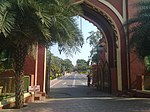 | ||
| 36. | Government Central Press | 1807 | George Town | ||||
| 37. | Thousand Lights Mosque | 1810 [27] | Anna Salai |  | |||
| 38. | Egmore Eye Hospital | 1819 | Egmore | ||||
| 39. | St Andrew's Church | Georgian church architecture | 1821 | Major De Havilland | Egmore | Built at a cost of 20,000 UK pounds | 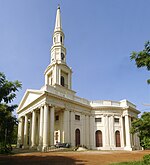 |
| 40. | Police headquarters | 1839 | Mylapore | Renovated in 1993. [36] |  | ||
| 41. | Tamil Nadu Police Museum | Indo-Saracenic | 1842 | Egmore | [37] | ||
| 42. | Christ Church | 1844 | Anna Salai | Possibly the first congregation outside Fort St George. | |||
| 43. | Higginbotham's | 1844 | Anna Salai | The first and the oldest existing book shop in India. | 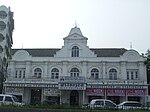 | ||
| 44. | Anderson Church | 1845 | Parry's Corner |  | |||
| 45. | Government College of Fine Arts and Crafts | Indo-Saracenic | 1850 | Robert Fellowes Chisholm | Egmore | The first school of arts in Asia | |
| 46. | Royapuram railway station | 1853 | Royapuram | Designed by William Adelpi Tracey. [38] Third oldest railway station in the country and the oldest in South India. [39] | 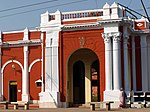 | ||
| 47. | The Mail | 1868 | Anna Salai | 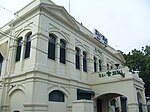 | |||
| 48. | Chennai Central railway station | Gothic Revival | 1873 | George Harding | Park Town | Built as a second terminus to decongest the Royapuram harbour station, which was being utilised for port movements. Built in a combination of styles, namely, Gothic and Romanesque. [40] | 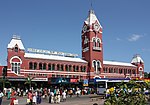 |
| 49. | Senate House, University of Madras | Indo-Saracenic | 1879 | Robert Fellowes Chisholm | Chepauk | Incorporates many elements of the Byzantine style. [41] The great hall of the Senate House is of immense height and proportions, considered to be the finest of its kind in India. [41] [42] |  |
| 50. | P Orr & Sons | 1879 | Anna Salai | 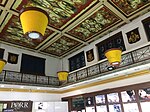 | |||
| 51. | Deputy Inspector General of Registration | 1880 | George Town | Housed registration department offices. Spread over 20,000 sq ft. [43] | |||
| 52. | Theosophical Society Headquarters Building | 1882 | Adyar |  | |||
| 53. | The Hindu | 1883 | Anna Salai | 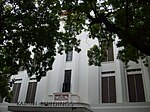 | |||
| 54. | General Post Office | Victorian Architecture | 1884 | Robert Fellowes Chisholm | George Town | Built at a cost of ₹ 680,000. [44] |  |
| 55. | Victoria Public Hall | Indo-Saracenic | 1888-1890 | Robert Fellowes Chisholm | Park Town | The venue of the first cinema show in Chennai. | 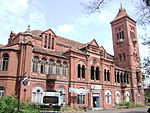 |
| 56. | Madras High Court | Indo-Saracenic | 1892 | J. W. Brassington, Henry Irwin | George Town | The court buildings are believed to be the second largest judicial complex in the world after the one in London. The complex also houses the largest number of courts in Asia. [45] [46] [47] | 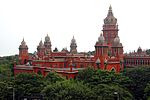 |
| 57. | St. Thomas Cathedral Basilica, Chennai | Gothic revival architecture | 1896 | Caption J. A. Power | Santhome | Built over the reputed tomb of Saint Thomas the Apostle by Portuguese explorers in 1523, and later rebuilt by the British in 1893. It is considered to be the oldest church in Chennai. | 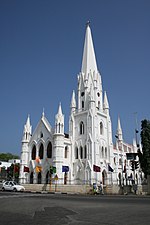 |
| 58. | Bharat Insurance Building | Indo-Saracenic | 1897 | Anna Salai | Originally known as Kardyl Building | ||
| 59. | State Bank of India Building | Victorian Architecture | 1897 | Col. Samuel Jacob | George Town |  | |
| 60. | Red Fort building at the Madras Medical College | 1897 | Park Town | [48] | |||
| 61. | King Institute of Preventive Medicine and Research | 1899 | Anna Salai, Guindy | ||||
| 62. | Dobbin Hall | 1904–05 | Madras Veterinary College (now located opposite) started functioning. |  | |||
| 63. | National Art Gallery | Indo-Saracenic | 1906 | Henry Irwin | Egmore | 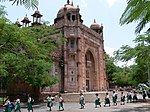 | |
| 64. | Egmore Railway Station | Indo-Saracenic | 1908 | Henry Irwin | Egmore | 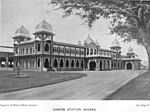 | |
| 65. | Madras Record Office | Indo-Saracenic | 1909 [49] | G. S. T. Harris | Egmore | Currently known as Tamil Nadu Archives/Department of Archives & Historical Research | |
| 66. | Royapuram fire temple | 1910 [50] | Hormusji Nowroji | Royapuram | The first and the only fire temple in the city. |  | |
| 67. | Ripon Building | Indo-Saracenic | 1913 | G.S.T Harris | Park Town | Built at a cost of ₹ 750,000. | 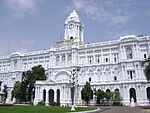 |
| 68. | Kilpauk Water Works | 1914 | Kilpauk | First water treatment facility with 80 mld capacity. [51] | |||
| 69. | Gove Building (formerly Cuddon Building) | 1916 | Anna Salai |  | |||
| 70. | Egmore court complex | 1916 | Egmore | Indo-Saracenic style of architecture. Spread over 8,640 square feet, it housed the Chief Metropolitan Magistrate Court, three additional Chief Metropolitan Magistrate courts and 10 magistrate and fast track courts. Restored in 2018 at a cost of ₹ 48 million. The same year, a new 6-storied 71,200-square-feet building, with 12 court halls, was constructed at the premises as additional court complex. [52] | |||
| 71. | College of Engineering | Indo-Saracenic | 1920 [53] | Guindy | Designed by consulting architect W. H. Nicholls and later by chief engineer F. J. Wilson. [38] | 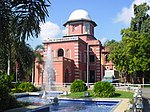 | |
| 72. | Southern Railway headquarters | Indo-Saracenic | 1921 | N. Grayson | Park Town | Originally built as the new Madras and Southern Mahratta Railway Company (MSMR) headquarters (successor of Madras Railway Company), replacing the general office of MSMR at Royapuram Railway Station. Built for the first time in India in reinforced concrete in classical and Dravidian styles. [54] | 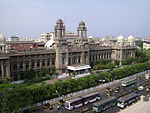 |
| 73. | Suguna Vilasa Sabha | 1936 | Anna Salai | Possibly one of the earliest drama theatres with stalwarts like Pammal Sambanda Mudaliar — now called SVS Club. | |||
| 74. | Bharathi Illam | Triplicane |  |









